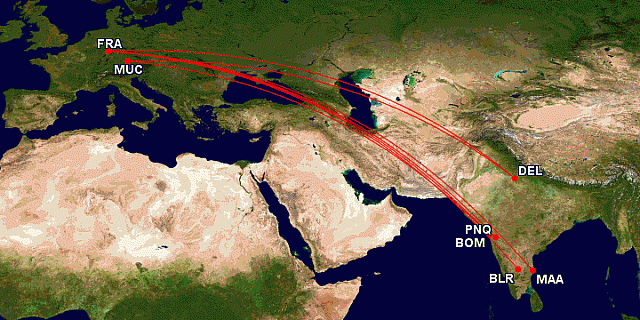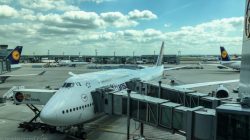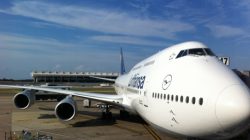German Airline Group Deutsche Lufthansa has revealed the first initial routes to receive the new “Queen of the Skies,” also known as the 747-8 series aircraft, starting in approximately one month’s time.
On Friday, Lufthansa announced on its social media newsroom page that its first Boeing 747-8 has been delivered fresh from Seattle, and commencing June 1st, the carrier will operate 6 weekly flights to its launch destination, Washington-Dulles International airport (IAD) in Virginia, from its primary hub at Frankfurt Main airport (FRA), where all of its 747-8 planes will be based for the time being.
As more of the jumbo jets join the fleet, Lufthansa will also deploy services from Frankfurt to Chicago O’Hare International (ORD) and Los Angeles International (LAX) airports using the 747-8, which naturally make sense given that both of these are high-volume markets as well as hub airports for Lufthansa’s Star Alliance partner United Airlines.
In addition, Lufthansa announced that two of its Indian markets would also be among the top-5 launch cities: alongside the three destinations listed above, both Indira Gandhi International airport (DEL) in Delhi, India and Bengaluru International airport (BLR) in Bangalore, India will also receive daily scheduled 747-8 services each by the end of the summer.
The latter two cities which rounded off the “top 5” launch list comes as somewhat of a surprise given that it was rumored Lufthansa has lower hanging fruit to choose from, in terms of markets seemingly in more critical need of the newer plane. Some of Lufthansa’s routes which utilize its older Boeing 747-400 model, such as from Frankfurt to Singapore or Frankfurt to Buenos Aires, are currently stretching the range limits of the aircraft. Other Lufthansa markets, such as Mexico City or Sao Paulo, are desperately in need of capacity up-gauges, but their airport infrastructures cannot accommodate Lufthansa’s mammoth Airbus A380 planes quite yet.
So, why India?
According to CAPA, the deployment of larger aircraft is Lufthansa’s “main mechanism to expand in the growing India market.” Currently, Lufthansa is facing two constraints within its Germany-India operations. Firstly, Germany and India are subject to bilateral agreements, which essentially limit the number of flights that a German airline can operate into India to 50 weekly frequencies (Lufthansa is currently utilizing 46 of those). Secondly, the Germany-India bilateral agreement specifically limits carriers from not operating aircraft larger than the 747 into Indian airports.
In other words, Lufthansa, alongside Emirates and other carriers, has been denied permission by the Indian Government to operate Airbus A380 plane into India, which in effect limits the amount of daily capacity Lufthansa can bring into the Indian markets it serves. Such a policy is largely viewed as beneficial for local carriers (this being the Indian airlines that the Govt of India is seeking to protect) but “detrimental to the larger market,” according to CAPA.
However, it could be argued that Lufthansa may be over-estimating the demand needs of its Indian markets, given that it has had mixed success in the burgeoning nation. While core “trunk” routes, such as between Frankfurt and Delhi, as well as Frankfurt and Chhatrapati Shivaji International airport (BOM) in Mumbai, have stuck around for sometime, the German carrier quietly pulled the plugs on its Frankfurt-Kolkata (CCU) and Frankfurt-Hyderabad (HYD) flights last year, citing poor premium demand and lack of profitability on these routes.
For years, Lufthansa had dominated market share on the North America-India traffic, offering competitive prices and convenient scheduling options for travelers transiting between the US and Canada and the largest population centers in India over its hubs in Frankfurt or Munich. Relative to its major European competitors, such IAG (which includes British Airways and Iberia), Air France-KLM, SWISS, Austrian and Aeroflot, Lufthansa has always been top dog as the #1 carrier with the largest weekly seat offerings between Europe and India. Even long-haul Indian carriers, such as Air India and Jet Airways, offer fewer weekly seats between the two continents.
However, the rise and growth of the Middle Eastern carriers over the years, such as Dubai-based Emirates, has weakened Lufthansa’s dominant position over the North America-India traffic. Emirates has not only expanded in the US, but also invested in a wise strategy of serving smaller Indian markets from the UAE, which currently lack nonstop service to major European hubs. This cuts down on travel time by minimizing additional stop-overs in the larger Indian cities, and Emirates’ pricing power and in-flight product offering are generally superior to Lufthansa’s.
While Lufthansa has not unveiled the seating configuration of its new Boeing 747-8 aircraft yet, it is rumored that such planes will likely offer an additional 15-20 extra seats over its current 747-400 aircraft, which seats approximately 344 passengers. Lufthansa’s Airbus A380 seats 526 passengers and its Airbus A340-600 seats 306, in a first/business/economy class layout.
Lufthansa’s currently weekly Germany-India schedules, from 30-Apr-2012 to 06-May-12
| Route | Weekly frequencies | Equipment |
|---|---|---|
| Bangalore-Frankfurt | 7 | 747-400 |
| Chennai-Frankfurt | 7 | A340-600 |
| Delhi-Frankfurt | 7 | 747-400 |
| Delhi-Munich | 7 | A340-600 |
| Mumbai-Frankfurt | 7 | 747-400 |
| Mumbai-Munich | 7 | A330-300 |
| Pune-Frankfurt | 4 | 737-800 |
*Source: CAPA – Centre for Aviation and Innovata. Note: Pune-Frankfurt operated by all-premium airline Privatair
Network routing: Germany to India

Further reading:
CAPA: “As A380 continues to be restricted in India, Lufthansa to deploy 747-8 to Delhi and Bangalore”
FlightGlobal: “Lufthansa targets low demand economy-class markets with 747-8I.”
VIDEO: On-board Lufthansa’s first Boeing 747-8 Intercontinental





